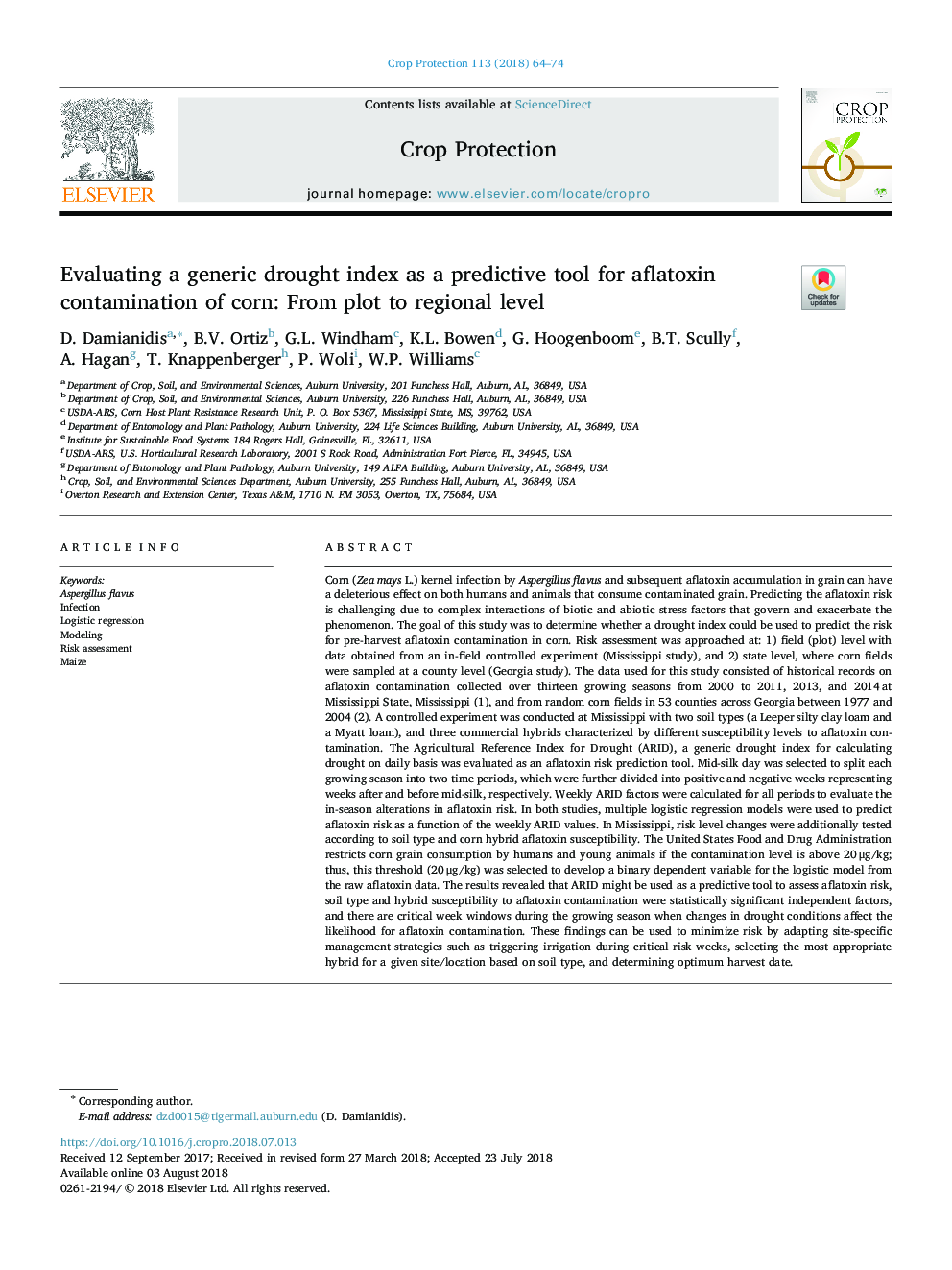| کد مقاله | کد نشریه | سال انتشار | مقاله انگلیسی | نسخه تمام متن |
|---|---|---|---|---|
| 8877882 | 1624274 | 2018 | 11 صفحه PDF | دانلود رایگان |
عنوان انگلیسی مقاله ISI
Evaluating a generic drought index as a predictive tool for aflatoxin contamination of corn: From plot to regional level
ترجمه فارسی عنوان
ارزیابی یک شاخص عمومی خشکسالی به عنوان یک ابزار پیش بینی کننده برای آلودگی آفلاتوکسین ذرت: از سطح به سطح منطقه
دانلود مقاله + سفارش ترجمه
دانلود مقاله ISI انگلیسی
رایگان برای ایرانیان
کلمات کلیدی
موضوعات مرتبط
علوم زیستی و بیوفناوری
علوم کشاورزی و بیولوژیک
علوم زراعت و اصلاح نباتات
چکیده انگلیسی
Corn (Zea mays L.) kernel infection by Aspergillus flavus and subsequent aflatoxin accumulation in grain can have a deleterious effect on both humans and animals that consume contaminated grain. Predicting the aflatoxin risk is challenging due to complex interactions of biotic and abiotic stress factors that govern and exacerbate the phenomenon. The goal of this study was to determine whether a drought index could be used to predict the risk for pre-harvest aflatoxin contamination in corn. Risk assessment was approached at: 1) field (plot) level with data obtained from an in-field controlled experiment (Mississippi study), and 2) state level, where corn fields were sampled at a county level (Georgia study). The data used for this study consisted of historical records on aflatoxin contamination collected over thirteen growing seasons from 2000 to 2011, 2013, and 2014â¯at Mississippi State, Mississippi (1), and from random corn fields in 53 counties across Georgia between 1977 and 2004 (2). A controlled experiment was conducted at Mississippi with two soil types (a Leeper silty clay loam and a Myatt loam), and three commercial hybrids characterized by different susceptibility levels to aflatoxin contamination. The Agricultural Reference Index for Drought (ARID), a generic drought index for calculating drought on daily basis was evaluated as an aflatoxin risk prediction tool. Mid-silk day was selected to split each growing season into two time periods, which were further divided into positive and negative weeks representing weeks after and before mid-silk, respectively. Weekly ARID factors were calculated for all periods to evaluate the in-season alterations in aflatoxin risk. In both studies, multiple logistic regression models were used to predict aflatoxin risk as a function of the weekly ARID values. In Mississippi, risk level changes were additionally tested according to soil type and corn hybrid aflatoxin susceptibility. The United States Food and Drug Administration restricts corn grain consumption by humans and young animals if the contamination level is above 20â¯Î¼g/kg; thus, this threshold (20â¯Î¼g/kg) was selected to develop a binary dependent variable for the logistic model from the raw aflatoxin data. The results revealed that ARID might be used as a predictive tool to assess aflatoxin risk, soil type and hybrid susceptibility to aflatoxin contamination were statistically significant independent factors, and there are critical week windows during the growing season when changes in drought conditions affect the likelihood for aflatoxin contamination. These findings can be used to minimize risk by adapting site-specific management strategies such as triggering irrigation during critical risk weeks, selecting the most appropriate hybrid for a given site/location based on soil type, and determining optimum harvest date.
ناشر
Database: Elsevier - ScienceDirect (ساینس دایرکت)
Journal: Crop Protection - Volume 113, November 2018, Pages 64-74
Journal: Crop Protection - Volume 113, November 2018, Pages 64-74
نویسندگان
D. Damianidis, B.V. Ortiz, G.L. Windham, K.L. Bowen, G. Hoogenboom, B.T. Scully, A. Hagan, T. Knappenberger, P. Woli, W.P. Williams,
